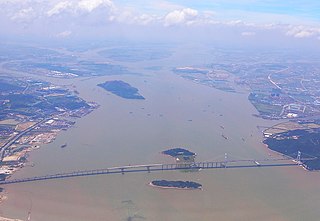Related Research Articles

The Pearl River, also known by its Chinese name Zhujiang and formerly often known as the Canton River, is an extensive river system in southern China. The name "Pearl River" is also often used as a catch-all for the watersheds of the Xi ("West"), Bei ("North"), and Dong ("East") rivers of Guangdong. These rivers are all considered tributaries of the Pearl River because they share a common delta, the Pearl River Delta. Measured from the farthest reaches of the Xi River, the 2,400-kilometer (1,500 mi)-long Pearl River system is China's third-longest river, after the Yangtze River and the Yellow River, and second largest by volume, after the Yangtze. The 453,700 km2 (175,200 sq mi) Pearl River Basin (珠江流域) drains the majority of Liangguang, as well as parts of Yunnan, Guizhou, Hunan and Jiangxi in China; it also drains northern parts of Vietnam's Northeast Cao Bằng and Lạng Sơn provinces.
The National Basketball League is a professional basketball minor league in China, called Chinese Basketball League (CBL) before 2006. It is commonly known as the NBL, and this name is often used even in Chinese.

Urban rail transit in the People's Republic of China encompasses a broad range of urban and suburban electric passenger rail mass transit systems including subway, light rail, tram and maglev. Some classifications also include non-rail bus rapid transport. China has the world's longest urban rail transit system that was more than 7,500 km long, as of 2020.
Tingzhou fu was a prefecture in Fujian province from the Tang Dynasty (唐朝) down to the early 20th century, when it was renamed Changting (help·info).

Shayang is a county of west-central Hubei province, People's Republic of China. Administratively, it is part of the prefecture-level city of Jingmen. The county is located south of the Jingmen city proper, west of the Han River, and north of the Chang Lake.

Hanchuan is a county-level city in east-central Hubei province, People's Republic of China. It is under the administration of Xiaogan City.

Longgan Lake is a freshwater lake in central China, divided between Susong County of Anhui Province and Huangmei County at the eastern extremity of Hubei Province. The lake is situated near the north bank of the middle reaches of Yangtze River, opposite Poyang Lake. The lake was named Longgan Lake in a 1955 decision which combined the names of two former lakes, Long Lake (龙湖) and Gan Lake (感湖).

The 2017 China floods began in early June 2017. More than 14.9017 million people in 10 provinces and municipalities and regions were affected, especially the southern and central provinces and regions of Guangxi, Guangdong, Hunan, Hubei, Jiangxi, Jiangsu, Anhui, Zhejiang, Shandong, Shaanxi, Yunnan, Sichuan, Gansu and Henan. Hunan was the hardest hit. A total of 18,100 houses were destroyed, and more than 9,821-square-metre (105,710 sq ft) of crops were inundated.
Shehua is an unclassified Sinitic language spoken by the She people of Southeastern China. It is also called Shanha, 山哈 (San-hak) or Shanhahua, 山哈话. Shehua speakers are located mainly in Fujian and Zhejiang provinces of Southeastern China, with smaller numbers of speakers in a few locations of Jiangxi, Guangdong and Anhui provinces.
Cennan is a town of Li County in Hunan, China. It has an area of 89.87 km2 (34.70 sq mi) with a population of 39,800. The town has 10 villages and a community under its jurisdiction, its seat is Zengjiahe Community.
Dongsong is a town in the west of Henan province, China. It is under the administration of Luoning County in the prefecture-level city of Luoyang. Dongsong was made a people's commune in 1958. It became a township in 1984. In 2011, Dongsong became a town.
Nantai is the largest island in the Min River of Fujian. It is located in the center of the Fuzhou Plain, surrounded by the "north harbor" of the Min (闽江北港) and the Wulong River, or "south harbor" of the Min. It has the nickname "Island of Chinese snowballs and jade" (琼花玉岛).

Yifengdian is a town in Jimo District, Qingdao, Shandong province, China. As of 2020, it has 99 villages under its administration:
References
- ↑ Needham, Joseph; Bray, Francesca; Huang Hsing-Tsung; Daniels, Christian; Menzies, Nicholas K. (1984). Science and Civilisation in China. ISBN 0-521-63262-5.
- ↑ Skinner, G. William, ed. (1977), The City in Late Imperial China, Stanford University Press
- 1 2 Skinner, G. William; Henderson, Mark; Yue, Zumou, A note regarding the Physiographic and Socioeconomic Macroregions of China
- ↑ Marks, Robert (1997). Tigers, Rice, Silk, and Silt: Environment and Economy in Late Imperial South China. Cambridge University Press. ISBN 0-521-59177-5.